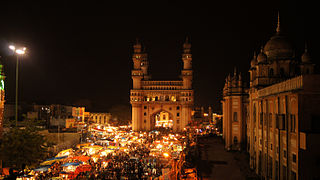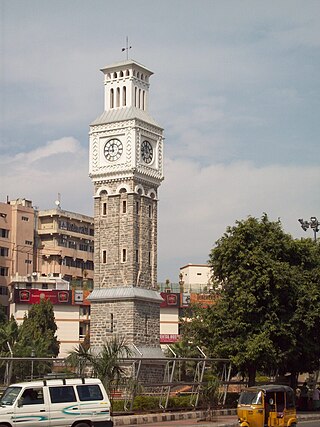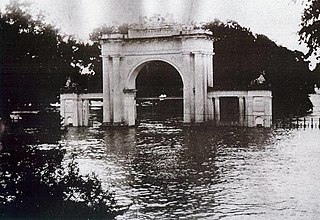
Hyderabad is the capital and largest city of the Indian state of Telangana. It occupies 650 km2 (250 sq mi) on the Deccan Plateau along the banks of the Musi River, in the northern part of Southern India. With an average altitude of 542 m (1,778 ft), much of Hyderabad is situated on hilly terrain around artificial lakes, including the Hussain Sagar lake, predating the city's founding, in the north of the city centre. According to the 2011 census of India, Hyderabad is the fourth-most populous city in India with a population of 6.9 million residents within the city limits, and has a population of 9.7 million residents in the metropolitan region, making it the sixth-most populous metropolitan area in India. With an output of US$74 billion, Hyderabad has the fifth-largest urban economy in India.

Hyderabad State was a princely state located in the south-central Deccan region of India with its capital at the city of Hyderabad. It is now divided into the present-day state of Telangana, the Kalyana-Karnataka region of Karnataka, and the Marathwada region of Maharashtra in India.

Telangana is a state in India situated in the southern part of the Indian peninsula on the high Deccan Plateau. It is the eleventh-largest state and the twelfth-most populated state in India as per the 2011 census. On 2 June 2014, the area was separated from the northwestern part of United Andhra Pradesh as the newly formed state of Telangana, with Hyderabad as its capital.

Secunderabad, also spelled as Sikandarabad, is a twin city of Hyderabad and one of the six zones of the Greater Hyderabad Municipal Corporation (GHMC) in the Indian state of Telangana. It is the headquarters of the South Central Railway zone. Named after the Mir Akbar Ali Khan Sikander Jah, Asaf Jah III, Nizam of the Asaf Jahi dynasty, Secunderabad was established in 1806 as a British cantonment. Although both the cities are together referred to as the twin cities, Hyderabad and Secunderabad have different histories and cultures, with Secunderabad having developed directly under British rule until 1948, and Hyderabad as the capital of the Nizams' princely state of Hyderabad. Since 1956, the city has housed the Rashtrapati Nilayam, the winter office of the president of India.

The Musi River is a major tributary of the Krishna River in the Deccan Plateau, flowing through Telangana, India. The river's historical name is Muchukunda. Hyderabad stands on the banks of the Musi River, which divides the historic Old City from the new city. The Musi River flows into Himayat Sagar and Osman Sagar, which are artificial lakes that act as reservoirs that once supplied the twin cities of Hyderabad and Secunderabad with drinking water. It originates in the Ananthagiri Hills, near Vikarabad. It generally flows towards the east, turning south at Chittaloor. It flows into the Krishna River at Vadapally near Miryalaguda in Nalgonda district.

Mir Osman Ali Khan, Asaf Jah VII was the last Nizam (ruler) of the Princely State of Kingdom of Hyderabad, the largest state in British India. He ascended the throne on 29 August 1911, at the age of 25 and ruled the Kingdom of Hyderabad between 1911 and 1948, until India annexed it. He was styled as His Exalted Highness (H.E.H) the Nizam of Hyderabad, and was widely considered one of the world's wealthiest people of all time. With some estimates placing his wealth at 2% of U.S. GDP, his portrait was on the cover of Time magazine in 1937. As a semi-autonomous monarch, he had his mint, printing his currency, the Hyderabadi rupee, and had a private treasury that was said to contain £100 million in gold and silver bullion, and a further £400 million of jewels. The major source of his wealth was the Golconda mines, the only supplier of diamonds in the world at that time. Among them was the Jacob Diamond, valued at some £50 million, and used by the Nizam as a paperweight.

Begumpet Airport is an airport that serves Hyderabad in Telangana, India. It is located in Begumpet and caters to general and military aviation. The airport is home to the Begumpet Air Force Station of the Indian Air Force. Begumpet was built by the Princely State of Hyderabad in the 1930s and served as the city's commercial airport for several decades. It eventually became overcrowded, and there was little room for expansion. Therefore, a new airport was erected in Shamshabad. Upon the opening of Rajiv Gandhi International Airport on 23 March 2008, Begumpet ceased all commercial operations.

Hyderabadi Muslims, also referred to as Hyderabadis, are a community of Deccani people, from the area that used to be the princely state of Hyderabad in the regions of Marathwada, Telangana, and Kalyana-Karnataka.

Parbhani is a city in Maharashtra state of India. It is the administrative headquarters of Parbhani District. Parbhani is one of the largest cities in Marathwada region. Parbhani is around 200 kilometres (120 mi) away from regional headquarters of Aurangabad while it is 491 km (305 mi) away from the state capital Mumbai.
Warangal Airport also Mamnoor Airport is located at Mamnoor, Warangal in the state of Telangana, India. The largest airport at the time, remained in service until 1981. The Government of Telangana is trying to revive the airport with some instate services. Around 1,000-acre (4.0 km2) of land are available for the proposed airport.

Moula-Ali commonly known as Moula Ali. It is a well-developed industrial and urban area in Malkajgiri Mandal, of the Medchal-Malkajgiri district, It is a part of Greater Hyderabad and also a part of Hyderabad Metropolitan Region of the Indian state of Telangana, This area is well connected with rail transportation through the Moula Ali Railway Station. It is noted for its Moula Ali hill, on top of which stands the Moula Ali Dargah and mosque, dedicated to Ali.
Asif Nagar is a major neighbourhood in the western part of Hyderabad, India. It is located north of the Musi River near Mehdipatnam. It is a mandal in the Hyderabad District and one of the oldest neighbourhoods that have existed for a long while.

The Old City of Hyderabad is a walled city of Hyderabad, Telangana, India, located on the banks of the Musi River built by Qutb Shahi sultan Muhammed Quli Qutb Shah in 1591 AD. There used to be a wall surrounding the Old City, most of which is destroyed. Mubariz Khan, the Mughal governor of Deccan Subah, had fortified the city in 1712 and was completed by Nizam of Hyderabad.
Bandlaguda Jagir is a satellite city of Hyderabad and a municipal corporation in Rangareddy district, Telangana, India. It Falls Under Gandipet mandal of Rajendranagar revenue division. It recently upgraded to a municipal corporation.

Ajmer Sharif Dargah is a Sufi Tomb (dargah) of the Sufi saint, Khawaja Moinuddin Chishti, located at Ajmer Shareef, Rajasthan, India.

The Great Musi Flood was a devastating flood that occurred on 28 September 1908 in Hyderabad on the banks of the Musi River. The city of Hyderabad was the capital of the Hyderabad State, ruled by the Nizam, Mir Mahbub Ali Khan.
Hyderabad was the capital of the Indian states of Telangana. It is a historic city noted for its many monuments, temples, mosques and bazaars. A multitude of influences has shaped the character of the city in the last 400 years.
The localities and neighborhoods of Hyderabad have unique oral histories, dating to the time of the Qutb Shahi dynasty, over 400 years ago, and are named after various people and things. Some are named after a major building or structure in the locality, others named for individuals. The names are mostly in Telugu and Urdu, the major languages of the city. This is a list of localities, neighborhoods and streets of Hyderabad and their etymology.
Nawab Mir Najaf Ali Khan is a grandson of the last Nizam of Hyderabad, Mir Osman Ali Khan and is a prominent figure known for heritage conservation, social initiatives, and legal representation of the Nizam's family.













